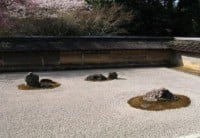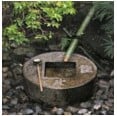
日本人の魂のルーツを辿る、京都「禅開眼」ツアー
This soul-enriching and soul-searching tour of the world-famous historic sites will give you an insight into the Japanese spirit, which is derived from Zen Buddhism. You can feast your eyes on the breath-taking Golden Pavilion and the beautiful Japanese strolling garden. This tour will also give you an invaluable oppotunity to experience transcendental Zen meditation in a tranquil atmosphere of Ryoanji Temple.

The Golden Pavilion, or Kinkakuji, is a three-story building on the grounds of the Rokuon-ji temple affiliated with the Shokoku-ji school of the Rinzai Buddhist denomination. The Golden Pavilion, which functions as a shariden, housing relics of the Buddha, is one of the most notable architectures in the Muromachi Period (1392 - 1573) and was designated as a World Cultural Heritage in 1994.
 The top two stories of the pavilion are covered with pure gold leaf, with the top floor built in traditional Chinese Cha'an style, or Zen shu butsuden zukuri and the middle floor in the style of warrior aristocrats,or Buke zukuri. The ground floor is rendered in shinden-zukuri-style, reminiscent of the residential style of the Heian imperial aristocracy without gold leaf.
The Golden Pavilion is set in a magnificent Japanese strolling garden (kaiyxJ薛shiki) on the pond called Kyoko-chi (Mirror Pond) with many islands
and stones representing the Buddhist creation story.
The top two stories of the pavilion are covered with pure gold leaf, with the top floor built in traditional Chinese Cha'an style, or Zen shu butsuden zukuri and the middle floor in the style of warrior aristocrats,or Buke zukuri. The ground floor is rendered in shinden-zukuri-style, reminiscent of the residential style of the Heian imperial aristocracy without gold leaf.
The Golden Pavilion is set in a magnificent Japanese strolling garden (kaiyxJ薛shiki) on the pond called Kyoko-chi (Mirror Pond) with many islands
and stones representing the Buddhist creation story.

Ryoanji is a temple located in northwest Kyoto, which belongs to the Myoshin-ji school of the Rinzai branch of Zen Buddhism. This temple is famous for “karesansui” or a dry landscape rock garden of elegant simplicity that consists of raked gravel and fifteen moss-covered boulders. Visitors can see only 14 of them at once, from whatever angle the garden is viewed. Only when you attain spiritual enlightenment through deep Zen meditation, can you see the last invisible stone with your mind’s eye. It is also believed that the implicit structure of the garden is designed to appeal to the viewers’ unconscious visual sensitivity.
 An object of interest in the precincts is “Tsukubai”, a carved stone receptacle into which water for ritual purification continuously flows. It has a unique inscription consisting of four characters 吾 唯 足 知, which translates as “I learn to be contented.” This concept, which is meant to reinforce the basic anti-materialistic teachings of Buddhism, is of utmost importance in Zen philosophy. It holds that those who learn to be contented are rich in spirit and character, whereas those who do not learn contentment are spiritually poor. even if they are materialistically wealthy.
An object of interest in the precincts is “Tsukubai”, a carved stone receptacle into which water for ritual purification continuously flows. It has a unique inscription consisting of four characters 吾 唯 足 知, which translates as “I learn to be contented.” This concept, which is meant to reinforce the basic anti-materialistic teachings of Buddhism, is of utmost importance in Zen philosophy. It holds that those who learn to be contented are rich in spirit and character, whereas those who do not learn contentment are spiritually poor. even if they are materialistically wealthy.
Information
| Date | May, 17th 2009 |
| Time and Places to meet | Aquaries School at Osaka |
| Itinerary |
|
| Contact | 0120-858-994 Ms.Kizawa, Mr T.Tanaka or email info@ies-school.co.jp |

















